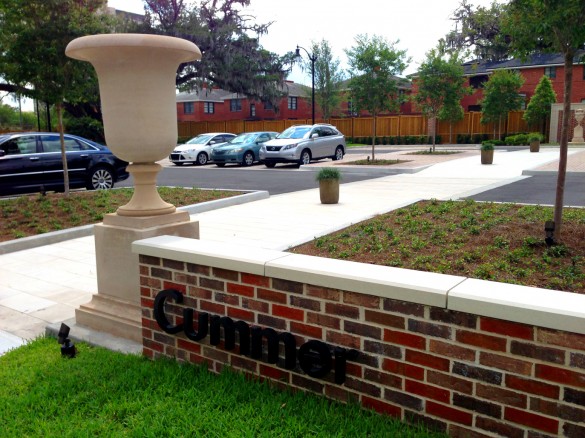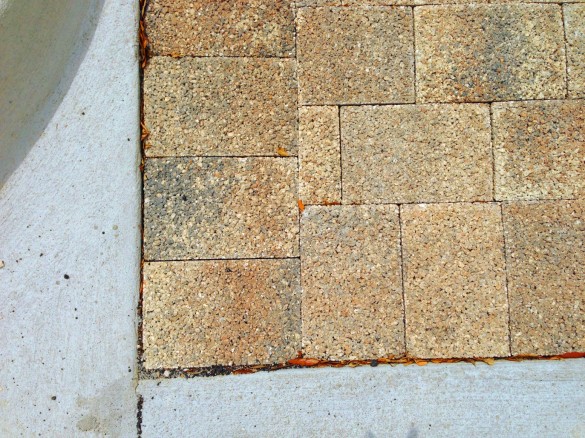 So, The Cummer Museum of Art & Gardens decided to make its parking lot disappear – environmentally speaking. That meant making the parking lot behave like there was no parking lot at all and returning the land’s behavior to pre-development status. The additions of more green space with the “right” plants and a natural stormwater management system have been put in place to accomplish these goals. Along the way we have created a friendlier neighborhood environment as well.
So, The Cummer Museum of Art & Gardens decided to make its parking lot disappear – environmentally speaking. That meant making the parking lot behave like there was no parking lot at all and returning the land’s behavior to pre-development status. The additions of more green space with the “right” plants and a natural stormwater management system have been put in place to accomplish these goals. Along the way we have created a friendlier neighborhood environment as well.
Returning to the natural behavior of the land includes connecting the surface of to the soil below, for a natural dispersal of rain water. A typical parking lot surface is made of impervious pavements shunting water to storm drains or puddles. The Cummer lot has used a permeable, environmentally-friendly paver designed to allow water to flow through the paver and be recaptured in the subsoil. The pavers sit on several layers of rock which serve to store and filter the water. Briefly reserved in the spaces (or voids) between the rocks, the water is available to feed near-by plants and then to slowly seep into and replenish the aquifer below.

Permeable Pavers
“Reconnecting” to the land also involves the inclusion of green spaces within the parking lot. Plants, including trees, not only serve to improve the view, they also to reduce the heat island effect; the effect that can result in raising the temperature of whole cities by 1 to 8 degrees F (World Meteorological Organization 1984). An urban forest is a big factor in combating the rise of temperatures within our city and part of this forest is included within the design of the Museum’s parking lot. Preserving the Live Oaks (Quercus virginiana) that were already in place and planting additional Live Oaks, East Palatka Hollies (Ilex x attenuate ‘East Palatka’), Crape Myrtles (Lagerstroemia indica ‘Muskogee’), and Ligustrum Trees (Ligustrum japonica), an extensive and growing canopy has been created. A canopy providing shade, reducing the temperature of the parking lot and cars within as well as protecting the lot and cars under it from damaging elements of the environment.
Providing shade is only one way that plants contribute to reducing temperatures, they also absorb solar radiation reducing radiated and reflected heat. Surface heat is reduced and the air is cooled through evaporation and transpiration. As city heat diminishes there is less need for artificial cooling and a noticeable reduction in utility costs. And the benefits of green spaces go beyond heat moderation.

Green spaces conceal some views while directing your gaze to others. They prevent glare and reflection and can provide acoustical control by filtering out loud noises; contributing to the safety of drivers and pedestrians along Riverside Avenue. The roots of the plants hold the soil together and the leaves and branches moderate the wind and slow the rate of rainfall hitting the ground. This reduces soil erosion and improves the quality of the water that reaches our River. Atmospheric purification occurs as air borne particulates are physically captured by plant material (leaves, branches, blades of grass) and gasses are absorbed and processed. One tree can remove 13 or more pounds of CO2 from the air in a year and produce enough oxygen for one to two people. These actions also help reduce smog and fog. The environment is furthered balanced by these green spaces providing suitable habitats for local wildlife and pleasant surroundings for local residents and visitors.
Technology and nature have built a parking lot. A well conceived plan and modern pavers, along with native and heat resistant plants serve to create a parking lot that is not only green but sustainable. A low water and maintenance need is environmentally and economically sound; structure and plantings reflect The Cummer and promotes aesthetically pleasing surroundings.
So, The Cummer Museum of Art & Gardens has “greened” its parking lot, creating an area that belongs to all of us, Riverside and Jacksonville as a whole.


